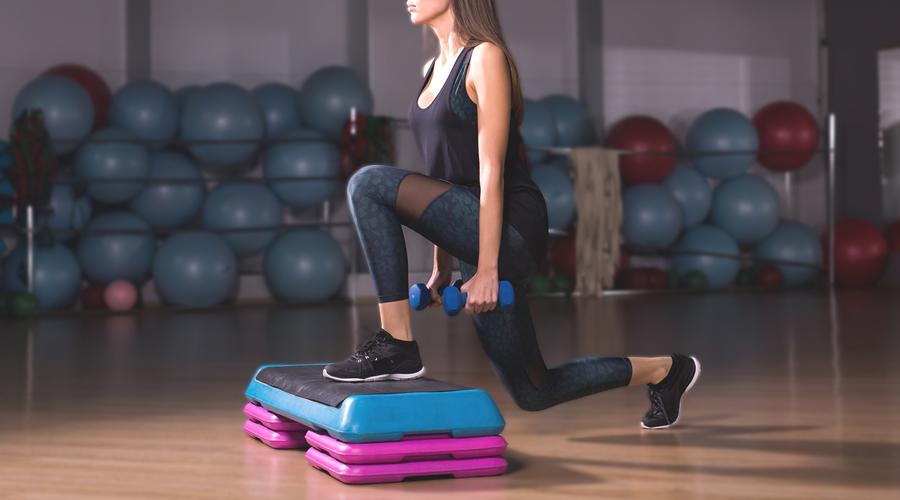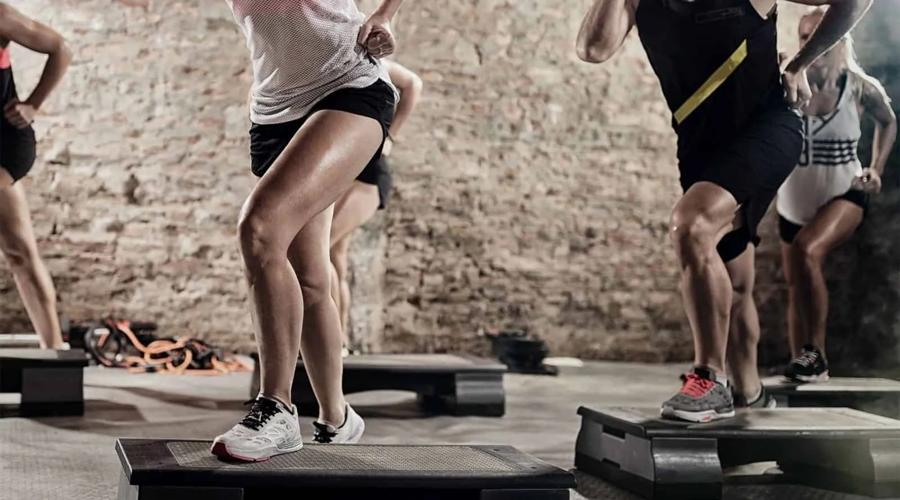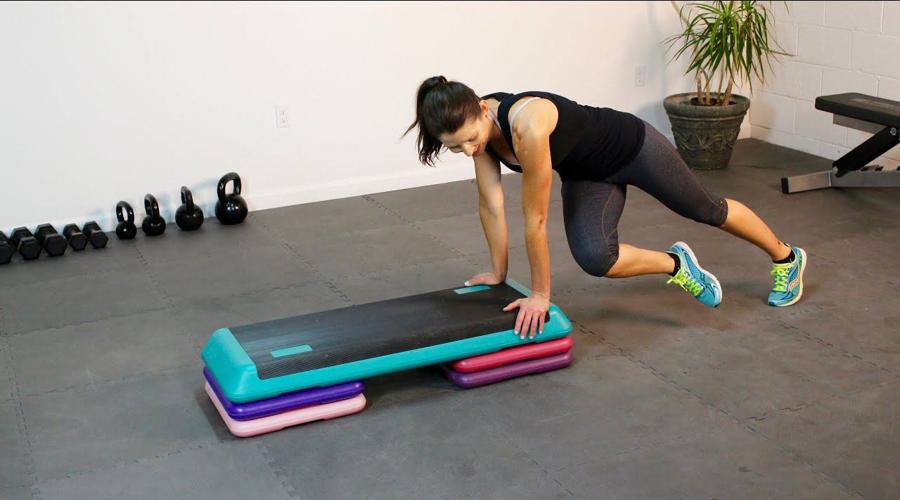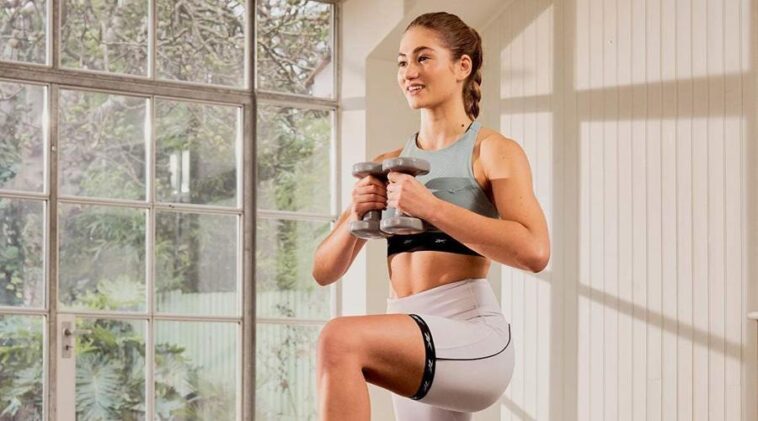The intensity of this HIIT step workout is quite high, as it involves short bursts of intense activity followed by short rest periods. The combination of step exercises, plyometrics, and bodyweight exercises will challenge your cardiovascular endurance, strength, and agility.
This workout is designed to burn a significant amount of calories and improve your endurance. The high-intensity intervals elevate your heart rate and keep it elevated throughout the workout, resulting in a higher calorie burn.
In addition to burning calories, HIIT workouts are also great for building endurance. The short bursts of intense activity followed by rest periods improve your body’s ability to utilize oxygen, allowing you to exercise for longer periods of time.
Overall, this HIIT step workout is an effective way to improve your fitness level, burn calories, and build endurance. However, it’s important to start slowly and gradually increase the intensity and duration of the workout as your fitness level improves.
What Is A Hiit Step Workout
A HIIT (High-Intensity Interval Training) step workout is a type of exercise that involves using a step or platform to perform a series of high-intensity exercises. This type of workout typically consists of short bursts of intense activity, followed by short periods of rest or active recovery.
During a HIIT step workout, you might perform exercises such as step-ups, jump squats, burpees, mountain climbers, and other high-intensity bodyweight exercises. The step or platform is used to add an extra challenge to the exercises, making them more intense and helping to increase calorie burn.
The main goal of a HIIT step workout is to push your body to its limits in a short amount of time. By alternating between high-intensity activity and periods of rest, you can maximize the benefits of your workout, including burning calories, improving endurance, and increasing cardiovascular fitness.
HIIT step workouts can be customized to fit any fitness level, from beginner to advanced. They are a great way to switch up your routine and challenge your body in new ways. However, as with any exercise program, it’s important to start slowly and gradually increase the intensity and duration of the workout as your fitness level improves.
What Are The Benefits Of A Hiit Step Workout
A HIIT step workout provides numerous benefits for your health and fitness. Here are some of the key benefits:
- Burns calories: HIIT step workouts are known for their calorie-burning ability. By performing high-intensity exercises, you can burn a significant number of calories in a short amount of time, which can help with weight loss and weight management.
- Improves cardiovascular fitness: HIIT step workouts elevate your heart rate, which strengthens your heart and lungs and improves your overall cardiovascular fitness.
- Increases endurance: HIIT step workouts involve short bursts of intense activity, followed by rest periods, which can improve your body’s ability to use oxygen and increase your endurance over time.
- Builds strength: HIIT step workouts use your own body weight as resistance, which can help build strength and muscle mass.
- Boosts metabolism: HIIT step workouts have been shown to boost your metabolism, which means you continue to burn calories even after your workout is over.
- Saves time: HIIT step workouts are typically shorter than traditional workouts, so you can get a great workout in a shorter amount of time.
- Can be done anywhere: HIIT step workouts require minimal equipment, so you can do them at home, in a park, or at a gym.
Overall, HIIT step workouts are a great way to improve your fitness level, burn calories, and build strength and endurance. However, as with any exercise program, it’s important to start slowly and gradually increase the intensity and duration of the workout as your fitness level improves.

How Long Does A Typical Hiit Step Workout Last
The duration of a HIIT step workout can vary depending on the individual’s fitness level and goals. A typical HIIT step workout can last anywhere from 20 to 45 minutes, including a warm-up and cool-down.
The high-intensity intervals in a HIIT step workout are usually short, lasting anywhere from 20 to 60 seconds, followed by a rest period or active recovery period. This cycle of high-intensity exercise and rest periods is repeated for several rounds, usually between four to eight rounds, depending on the workout’s design.
However, the duration of a HIIT step workout can also depend on the specific exercises, number of sets and repetitions, and the intensity level. The length of the workout can also be influenced by the individual’s fitness level, as beginners may need more rest periods, whereas advanced individuals may need less rest periods and more high-intensity exercise.
Ultimately, the goal of a HIIT step workout is to push the body to its limits in a short amount of time to achieve maximum benefits. It’s essential to listen to your body and start slowly, gradually increasing the intensity and duration of the workout as your fitness level improves.
What Equipment Is Needed For A Hiit Step Workout
A HIIT step workout requires minimal equipment, making it an excellent option for those who want to exercise at home or in a small space.
Here’s a list of equipment that may be needed for a HIIT step workout:
- Step platform: A step platform is the main piece of equipment needed for a HIIT step workout. The step platform should be sturdy, adjustable, and have a non-slip surface.
- Comfortable workout clothes: Wear comfortable, breathable workout clothes that allow you to move freely during the workout.
- Athletic shoes: Choose athletic shoes that provide proper support and cushioning for your feet.
- Water bottle: Hydration is essential during a HIIT step workout, so be sure to have a water bottle handy.
Optional equipment:
- Resistance bands: Resistance bands can be used to add resistance to certain exercises and help build strength.
- Dumbbells: Dumbbells can be incorporated into certain exercises to add weight and increase resistance.
- Towel: A towel can be used to wipe away sweat during the workout.
- Heart rate monitor: A heart rate monitor can help you track your heart rate and ensure you are working at the appropriate intensity level.
Overall, the equipment needed for a HIIT step workout is minimal, making it an accessible and convenient workout option. However, it’s important to invest in high-quality equipment to ensure your safety and prevent injury during the workout.
How Can Beginners Do A Hiit Step Workout
HIIT step workouts can be challenging, especially for beginners. However, with the right approach, beginners can still perform a HIIT step workout and reap its benefits. Here are some tips to help beginners do a HIIT step workout:
Start with a low platform height: Beginners should start with a lower platform height to allow them to focus on proper form and technique before moving on to higher platform heights.
Modify the exercises: Beginners can modify the exercises by performing low-impact variations or reducing the intensity and speed of the movements. For example, instead of jumping, they can step up and down on the platform.
Follow a beginner-friendly workout plan: Many fitness resources, such as online workout videos, apps, or personal trainers, offer beginner-friendly HIIT step workout plans. These plans typically have lower intensity levels and longer rest periods, making them more manageable for beginners.
Focus on proper form: It’s essential to focus on proper form and technique during a HIIT step workout to prevent injury. Beginners should take the time to learn the proper form for each exercise and focus on maintaining it throughout the workout.
Listen to your body: It’s important to listen to your body and not push yourself too hard during a HIIT step workout. Beginners should take breaks when needed and stop the workout if they experience any pain or discomfort.
Overall, beginners can do a HIIT step workout by starting with a lower platform height, modifying the exercises, following a beginner-friendly workout plan, focusing on proper form, and listening to their body. As their fitness level improves, they can gradually increase the intensity and duration of the workout.

What Is The Difference Between A Hiit Step Workout And A Regular Step Workout
The main difference between a HIIT step workout and a regular step workout is the intensity and structure of the workout.
A regular step workout typically involves using a step platform to perform a series of low-impact aerobic exercises, such as step-ups, knee lifts, and kicks. The workout is usually done at a steady pace for an extended period, typically 30 to 60 minutes. The focus is on building endurance and burning calories through sustained aerobic exercise.
On the other hand, a HIIT step workout is a type of high-intensity interval training that combines short bursts of intense exercise with brief rest periods. The exercises in a HIIT step workout are typically more challenging, involving plyometric movements and bodyweight exercises such as jump squats, burpees, and mountain climbers.
The workout is designed to push the body to its limits in a short amount of time, typically lasting between 20 to 45 minutes.
Overall, the main difference between a HIIT step workout and a regular step workout is the intensity level and the structure of the workout. A regular step workout is a low-impact aerobic exercise that focuses on building endurance, while a HIIT step workout is a high-intensity exercise that focuses on burning calories, building endurance, and improving overall fitness levels.
How Many Calories Burn During A Hiit Step Workout
The number of calories burned during a HIIT step workout depends on various factors, such as the duration of the workout, the intensity level, and the individual’s body weight and fitness level. However, on average, a 30-minute HIIT step workout can burn anywhere between 300 to 500 calories.
The high-intensity intervals in a HIIT step workout elevate the heart rate, which increases the number of calories burned during the workout. Additionally, the use of a step platform adds an extra challenge to the exercises, making them more intense and helping to increase calorie burn.
It’s important to note that the number of calories burned during a HIIT step workout can vary depending on the individual’s body composition, fitness level, and effort level during the workout.
However, it’s generally accepted that HIIT step workouts are an effective way to burn a significant number of calories in a short amount of time.
How Can A Hiit Step Workout Help With Weight Loss
HIIT step workouts are a great way to aid weight loss by burning calories and increasing metabolism. Here are some ways a HIIT step workout can help with weight loss:
Burns calories: HIIT step workouts involve short bursts of intense exercise, followed by brief periods of rest, which help to burn a significant number of calories in a short amount of time.
Increases metabolism: HIIT step workouts can increase metabolism and keep it elevated for several hours after the workout is over. This helps to burn additional calories throughout the day.
Targets multiple muscle groups: HIIT step workouts target multiple muscle groups, which helps to build lean muscle mass. Lean muscle mass increases metabolism and helps the body to burn more calories at rest.
Improves cardiovascular fitness: HIIT step workouts elevate the heart rate, which strengthens the heart and lungs, improves blood flow, and helps to boost overall cardiovascular health.
Boosts mood: HIIT step workouts have been shown to boost mood and reduce stress, which can help to reduce emotional eating and improve overall wellness.
Overall, HIIT step workouts can help with weight loss by burning calories, increasing metabolism, building lean muscle mass, improving cardiovascular fitness, and boosting mood. However, it’s important to combine HIIT step workouts with a healthy diet and lifestyle to achieve optimal weight loss results.

What Are Some Hiit Step Workout Routines For Beginners
Here are some HIIT step workout routines for beginners that can help to build endurance and improve cardiovascular fitness:
Basic Step-Ups
- Step up onto the platform with one foot, then bring the other foot up
- Step down one foot at a time
- Repeat for 30 seconds
- Rest for 30 seconds
Step-Up and Knee Lift
- Step up onto the platform with one foot, then lift the opposite knee to hip height
- Step down and repeat on the other side
- Repeat for 30 seconds
- Rest for 30 seconds
Lateral Step-Ups
- Step onto the platform with one foot, then bring the other foot up to meet it
- Step down to the side with one foot, then bring the other foot down to meet it
- Repeat for 30 seconds on one side, then switch to the other side for 30 seconds
- Rest for 30 seconds
Jump Squats
- Stand with feet shoulder-width apart, then jump onto the platform
- Squat down and touch the platform with your fingertips
- Jump back down to the ground and repeat for 30 seconds
- Rest for 30 seconds
Mountain Climbers
- Start in a plank position with your hands on the platform
- Bring one knee up to your chest, then switch legs quickly
- Repeat for 30 seconds
- Rest for 30 seconds
Remember to warm up before starting the workout and cool down afterward. As a beginner, start with a low platform height and gradually increase the intensity and duration of the workout as your fitness level improves.
How Often Should Do A Hiit Step Workout
The frequency of doing a HIIT step workout depends on the individual’s fitness level, goals, and recovery time. However, a general recommendation is to do a HIIT step workout 2-3 times per week, with at least one day of rest between each workout.
HIIT step workouts are high-intensity exercises that can put a strain on the body, so it’s important to allow time for the body to rest and recover between workouts. Overtraining can lead to injury and can also decrease the effectiveness of the workout.
It’s also important to vary your workouts to prevent boredom and to challenge your body in different ways. Consider alternating between HIIT step workouts and other types of exercises, such as strength training or low-impact cardio.
Ultimately, the frequency of doing a HIIT step workout should be based on your fitness level, goals, and how your body responds to the workout. As your fitness level improves, you can gradually increase the frequency and intensity of the workout.
How Can A Hiit Step Workout Be Done At Home Without Any Equipment
A HIIT step workout can be done at home without any equipment by using bodyweight exercises and modifying the exercises to simulate the use of a step or platform. Here are some examples of HIIT step exercises that can be done at home without any equipment:
High knees:
Stand in place and lift your knees as high as you can, alternating legs quickly.
Jumping jacks:
Stand with your feet together, then jump and spread your feet out while raising your arms overhead.
Burpees:
Start in a standing position, then squat down, jump back into a plank position, jump forward, and jump up with your arms overhead.
Plyometric lunges:
Start in a lunge position, then jump and switch legs quickly.
Mountain climbers:
Start in a plank position and alternate bringing your knees up towards your chest.
Jump squats:
Start in a squat position, then jump up with your arms overhead.
To simulate the use of a step or platform, you can perform exercises such as high knees or jump squats by jumping up onto an imaginary step or platform.
You can also use a sturdy chair or bench as a step platform, but be sure to test the stability of the object before using it for exercises.
Overall, a HIIT step workout can be done at home without any equipment by using bodyweight exercises and modifying the exercises to simulate the use of a step or platform. It’s important to warm up before starting the workout and cool down afterward to prevent injury and promote recovery.

Conclusion
In conclusion, HIIT step workouts are an effective and challenging way to improve fitness levels, burn calories, build endurance, and increase metabolism. These workouts involve short bursts of intense exercise, followed by brief periods of rest or active recovery, and are typically done using a step or platform.
HIIT step workouts can be modified to suit different fitness levels and can be done with minimal equipment, making them a convenient option for those who want to exercise at home or in a small space.
By incorporating HIIT step workouts into a fitness routine, individuals can improve overall health, boost mood, and achieve their fitness goals in a shorter amount of time than traditional workouts. However, it’s important to start slowly, focus on proper form, and listen to your body to prevent injury and achieve optimal results.
How can I track my progress with a HIIT step workout?
You can track your progress with a HIIT step workout by keeping a workout log and recording the number of sets, reps, and weights used for each exercise. You can also use a fitness tracker or app to monitor your heart rate and calorie burn.
How can I make a HIIT step workout more challenging?
You can make a HIIT step workout more challenging by increasing the height of the step platform, adding weights or resistance bands, or increasing the duration of the high-intensity intervals.
What should I eat before a HIIT step workout?
You should eat a meal or snack containing carbohydrates and protein about 30-60 minutes before a HIIT step workout to provide energy and prevent muscle breakdown.
What should I eat after a HIIT step workout?
You should eat a meal or snack containing carbohydrates and protein within 30-60 minutes after a HIIT step workout to replenish glycogen stores and promote muscle recovery.
How can I track my progress with a HIIT step workout?
You can track your progress with a HIIT step workout by keeping a workout log and recording the number of sets, reps, and weights used for each exercise. You can also use a fitness tracker or app to monitor your heart rate and calorie burn.




